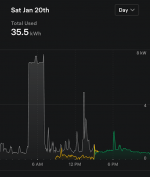wwhitney
Senior Member
- Location
- Berkeley, CA
- Occupation
- Retired
The graph below may be informative, it shows my household power draw over time for Saturday.
The huge plateau in the morning is from charging the EV. It was under 3 hours, but the EV was only down maybe 40% (and it's a small EV, 40 kWh). If it had been down 60% or more, as happens, it would have lasted over 3 hours.
This illustrates both that the EVSE is a continuous load, and that its power consumption profile is unlike any other load in my residence.
Cheers, Wayne

The huge plateau in the morning is from charging the EV. It was under 3 hours, but the EV was only down maybe 40% (and it's a small EV, 40 kWh). If it had been down 60% or more, as happens, it would have lasted over 3 hours.
This illustrates both that the EVSE is a continuous load, and that its power consumption profile is unlike any other load in my residence.
Cheers, Wayne



